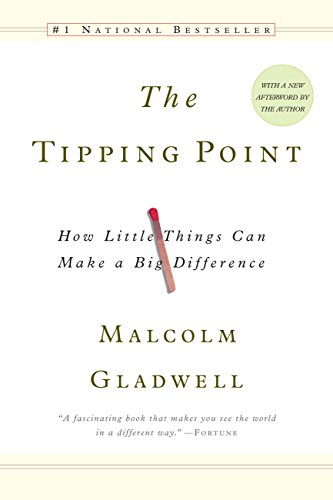

This article is an excerpt from the Shortform summary of "The Tipping Point" by Malcolm Gladwell. Shortform has the world's best summaries of books you should be reading.
Like this article? Sign up for a free trial here .
Who is Malcolm Gladwell’s “maven”? How are mavens crucial to the spread of ideas and important for business?
Mavens are information specialists. They are the kinds of people who are endlessly curious and adept at gathering and retaining information on a wide variety of (sometimes obscure) topics. The term comes from Malcolm Gladwell’s The Tipping Point.
We’ll cover the role of Malcolm Gladwell’s mavens in business and why they’re crucial to the spread of ideas, services, and products.
Malcolm Gladwell’s Mavens
The Law of the Few is about the people who spread messages, ideas, or viruses and cause epidemics to tip. These are specific types of people who have the contacts, knowledge, and social skills to effectively spread an idea far and wide. The types are connectors, mavens, and salesmen.
Mavens: People Who Are Always in the Know
While Connectors are people specialists, Tipping Point‘s Mavens specialize in information. They are the kinds of people who are endlessly curious and adept at gathering and retaining information on a wide variety of (sometimes obscure) topics.
In a marketing and retail context, these people are called “Market Mavens” or “price vigilantes.” They watch price fluctuations, know when stores are having sales, collect coupons, and know the days when the coupons are worth double.
According to Malcolm Gladwell, Mavens not only collect information, but they also enthusiastically share their knowledge with other people. They are socially motivated to help people with the information they’ve gathered; a Maven may give you some of her coupons, and remind you when a sale is coming up. Tipping Point‘s Mavens have no ulterior motive for sharing information; they just want to help. Their genuine helpfulness inspires more trust and credibility, so when they give recommendations people tend to take them more seriously.
Whereas a Connector’s influence lies in knowing many people and spreading information widely, Malcolm Gladwell’s maven’s influence is in the power of her recommendation. People know that Mavens are knowledgeable and trustworthy sources of information, so a Maven’s word carries a lot of weight. If a Maven suggests you check out a budding epidemic, you’re inclined to listen.
- For example, a Connector might recommend a restaurant to 10 people, and five of them take her advice and try out the restaurant. A Maven might recommend a restaurant to five people, and all of them try it out, because they know that she always has reliable information about the hottest restaurants and best-kept secrets.
According to Malcolm Gladwell, Mavens are both teachers and students: They love to learn new information as much as they love to share it. In this way, Mavens mine their social contacts for tips and recommendations, while also doling out their own advice. In a social epidemic, Mavens serve as data banks — they carry the message, with authoritativeness.
Connectors, Mavens, and Salesmen are more than mere messengers, spreading ideas to a wide variety of people and convincing them to follow suit; they can also act as translators, making a radical new trend, product, or idea more palatable to the public masses.
(Shortform note: Gladwell doesn’t say that every epidemic necessarily needs all three personality types. Depending on the situation, some combination of these messengers work in conjunction with the other principles to tip an epidemic.)
Translating Messages, Products, and Services
In general, most people naturally resist change and innovation in favor of what’s familiar, comfortable, and working well enough. A much smaller population (the Innovators and Early Adopters) give an idea or product its kickstart, but the masses ultimately must get on board for an epidemic to take hold. This is where translation is necessary to make new ideas or products more palatable and bridge the gap between the risk-takers and the rest of us.
- (Shortform example: Think of this in terms of fashion trends. Fashion-forward Innovators may start wearing jeans that are totally ripped and shredded. That’s a little extreme for the mainstream shoppers, but translators take it back a notch and wear jeans with smaller holes in the knees, bridging the gap and making the trend more appealing to the majority.)
According to Malcolm Gladwell, Connectors, Mavens, and Salesmen each use their strengths differently to translate messages in a way that they take on a deeper meaning to the people receiving the message (thus making it stickier).
- As members of so many different worlds, Connectors are able to act as an intermediary in translating ideas from one community to another.
- Mavens’ extensive knowledge and detailed understanding of (sometimes complex) topics allows them to adeptly explain information to people with less or no expertise.
- Salesmen use their nonverbal abilities and ability to connect emotionally with people to make information and ideas more relatable.
Case Study–Malcolm Gladwell’s Mavens: How Airwalk Got Preppy Kids to Wear Skater Shoes
A San Diego-based shoe company named Airwalk began producing shoes in the mid-1980s aimed at hard-core skateboaders, but achieved epidemic popularity in the 1990s through an advertising campaign that translated skater fashion trends to mainstream buyers.
Airwalk’s advertising agency, Lambesis, hired a Maven named DeeDee Gordon to spot social epidemics that were about to tip — from kung-fu movies to interest in Tibet and the Dalai Lama. Gordon contracted a team of Innovators across the country, and regularly checked in with them to find out what music, fashion, television shows, and topics they were interested in. By noting their varied interests over time, then seeing what the mainstream caught onto several months later, she was able to track and forecast trends and ideas that would soon advance from the Innovators and Early Adopters to the Majority.
Lambesis put a twist on those themes and, just as the trends were hitting mainstream popularity, incorporated them into the shoe ads in a way that appealed to young buyers (e.g. a kung-fu parody where the Airwalk-wearing main character uses his skateboard to fight off the ninja villains). Gordon used her Mavenly knowledge of trends to tap into the public’s interests and translate a niche shoe designed for skateboarders to mainstream popularity.
Lambesis’s ad campaigns not only rode the wave of these trends, but themselves helped tip these trends into epidemics by translating less accessible ideas into more digestible forms. For example, they took many young adults’ growing interest in the Dalai Lama and the occupation of Tibet and created an ad showing a Tibetan monk cheating on a test by looking at notes he’d scrawled on the sides of his Airwalk shoes. The ads tweaked somewhat obscure trends and translated them into a context that was more familiar to the mainstream.
———End of Preview———

Like what you just read? Read the rest of the world's best summary of "The Tipping Point" at Shortform . Learn the book's critical concepts in 20 minutes or less .
Here's what you'll find in our full Tipping Point summary :
- What makes some movements tip into social epidemics
- The 3 key types of people you need on your side
- How to cause tipping points in business and life






